Abstract
An index marker map of chromosome 9 has been constructed using the Centre d'Etude du Polymorphisme Humain reference pedigrees. The map comprises 26 markers, with a maximum intermarker interval of 13.1 cM and only two intervals > 10 cM. Placement of all but one marker into the map was achieved with > 10,000:1 odds. The sex-equal length is 151 cM, with male length of 121 cM and female length of 185 cM. The map extends to within 2%-3% of physical length at the telomeres, and its coverage therefore is expected to be within 20-30 cM of full map length. The markers are all of the GT/CA repeat type and have average heterozygosity .77, with a range of .60-.89. The map shows both marked contraction of genetic distance relative to physical distance in the pericentromeric region and expansion in the telomeric regions. Genotypic data were carefully examined for errors by using the crossover routine of the program DATAMAN. Five new mutations were observed among 17,316 meiotic events examined. There were two double-crossover events occurring within an interval of 0-10 cM, and another eight were observed within an interval of 10-20 cM. Many of these could be due to additional mutational events in which one parental allele converted to the other by either gene conversion or random strand slippage. When there was no correction for these possible mutational events, the number of crossovers displayed by the maternal and paternal chromosomes was significantly different (P < .001) from that predicted by the Poisson distribution, which would be expected in the absence of interference. In addition, the observed crossover distribution for paternally derived chromosomes was similar to that predicted from cytogenetic chiasma frequency observations. In all, the data strongly support the occurrence of strong positive interference on human chromosome 9 and suggest that flanking markers at an interval of < or = 20 cM are generally sufficient for disease gene inheritance predictions in presymptomatic genetic counseling by linkage analysis.
Full text
PDF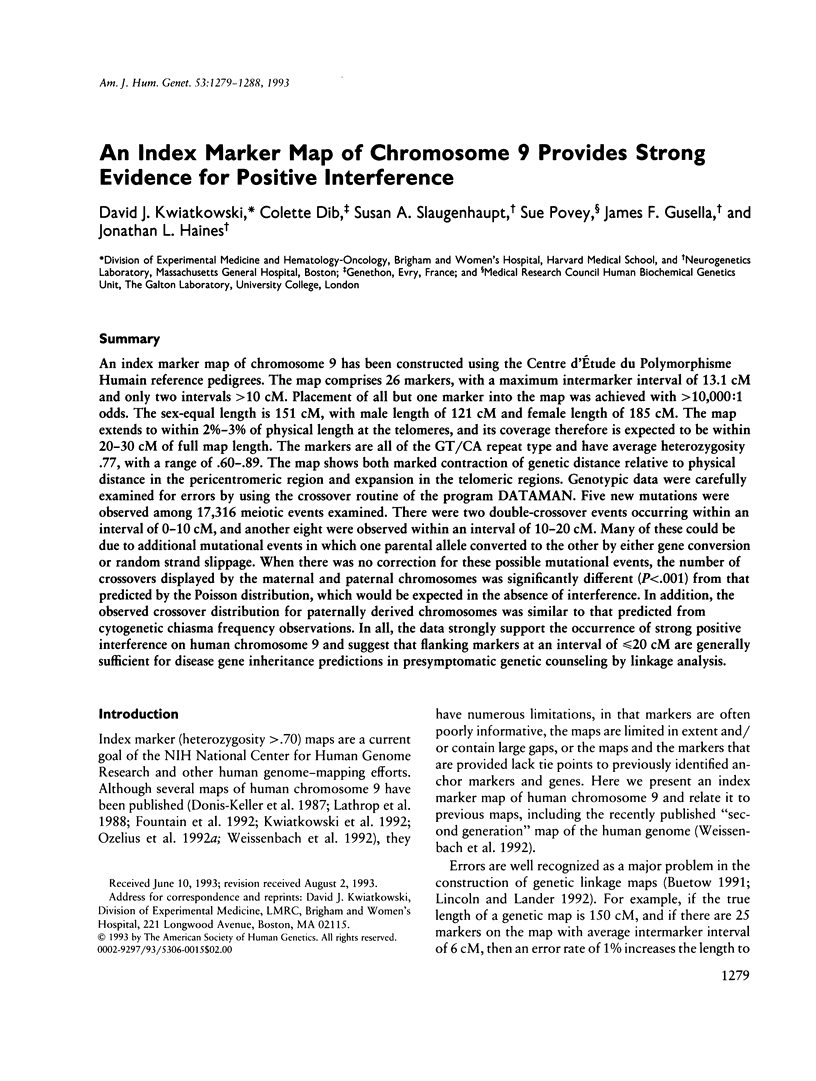
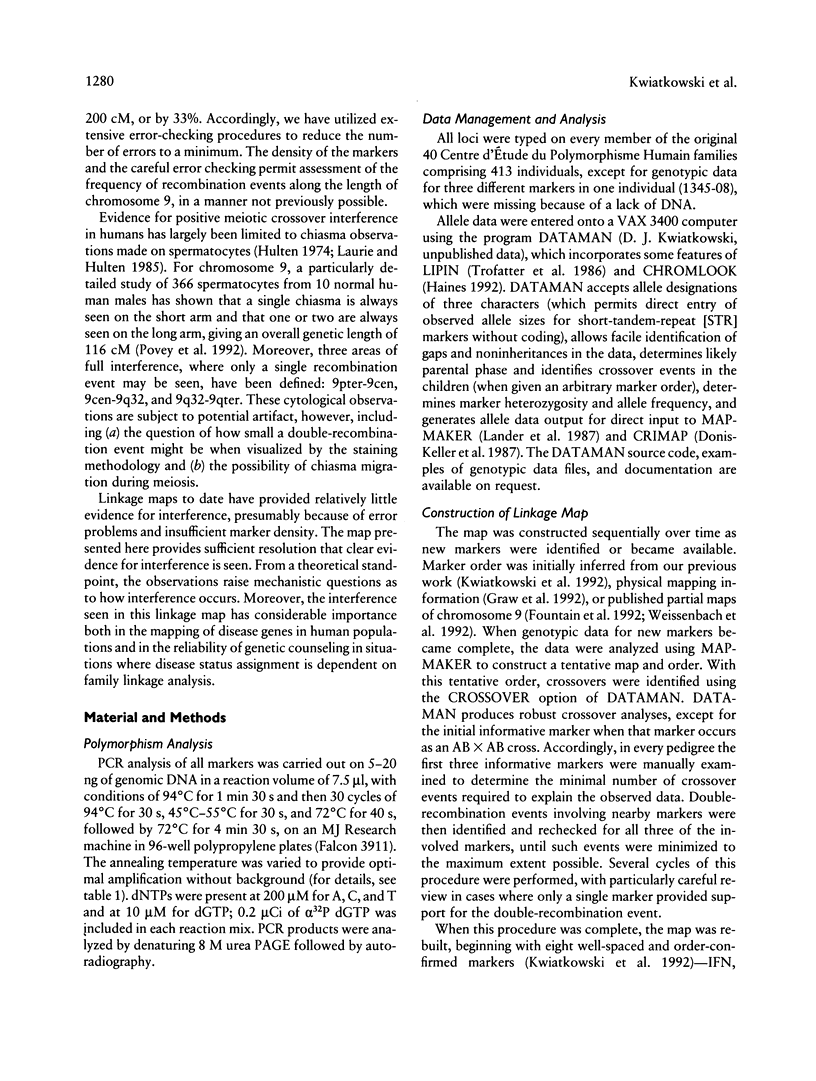
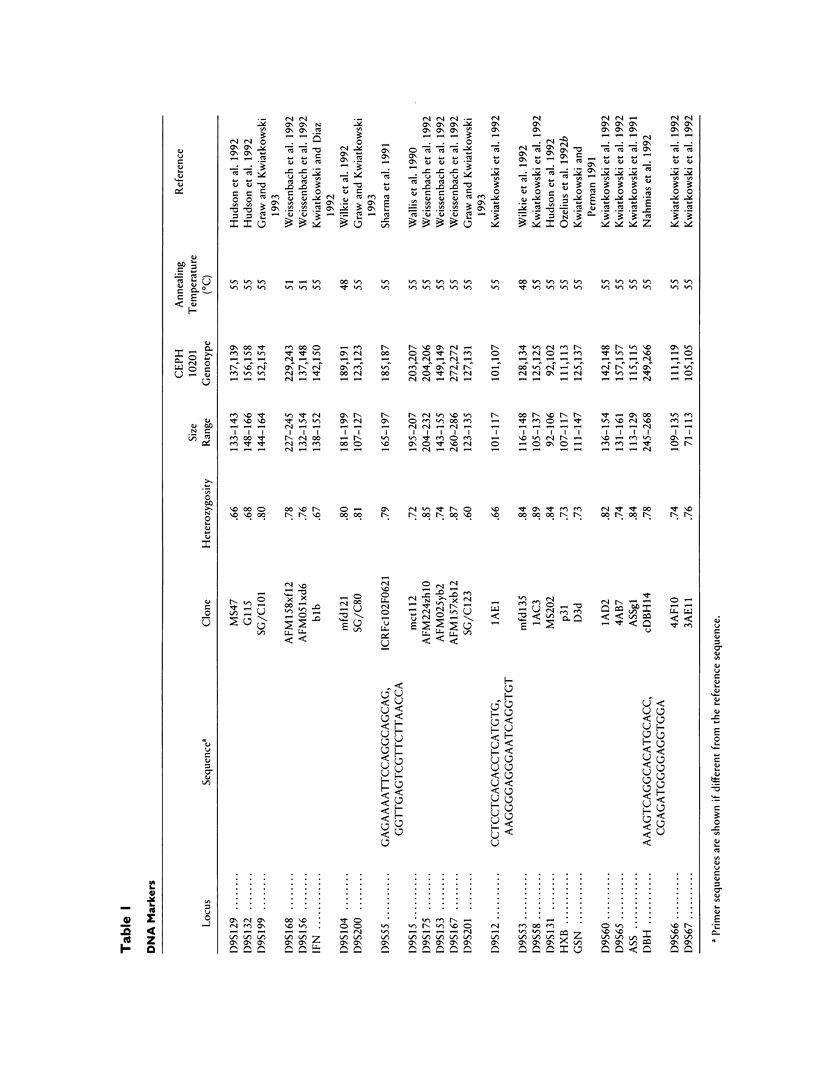
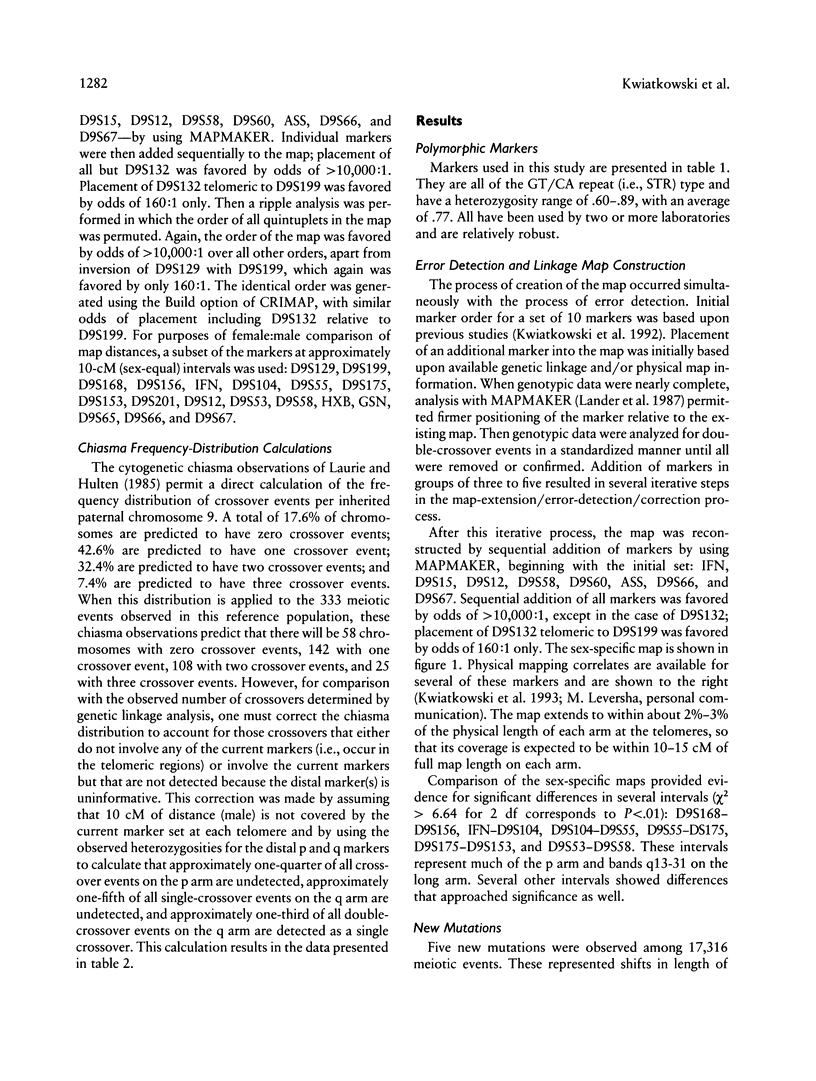
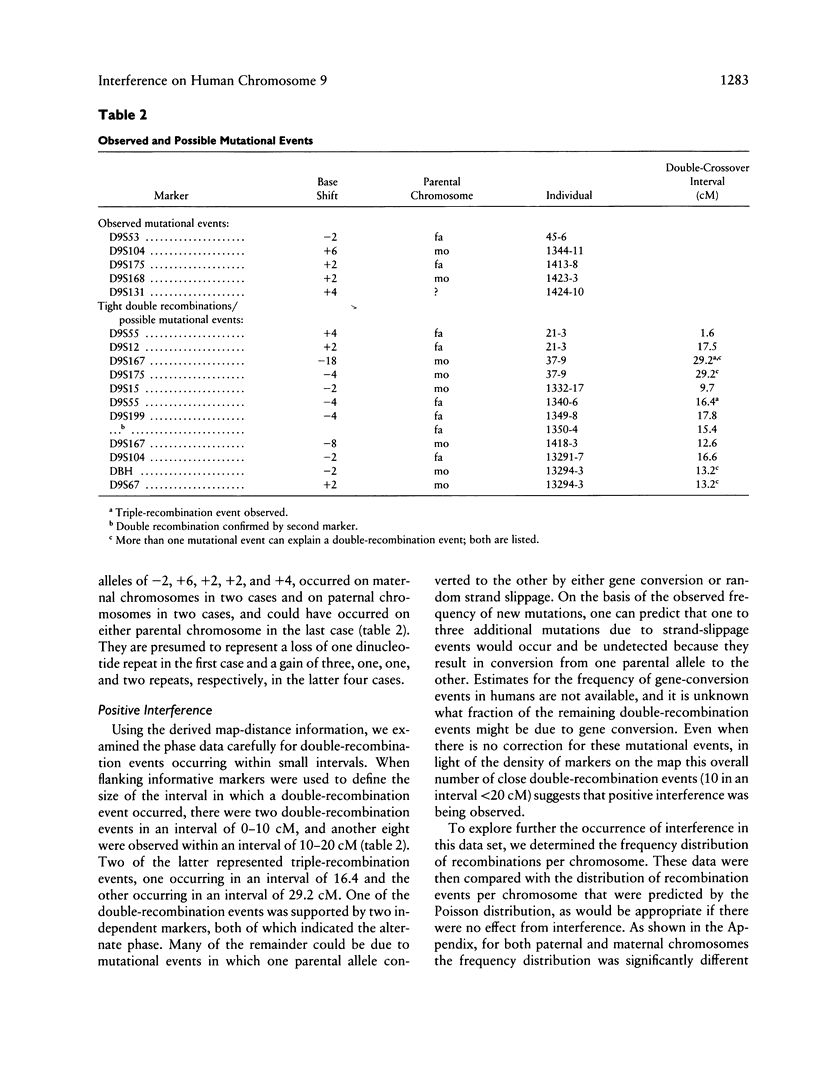
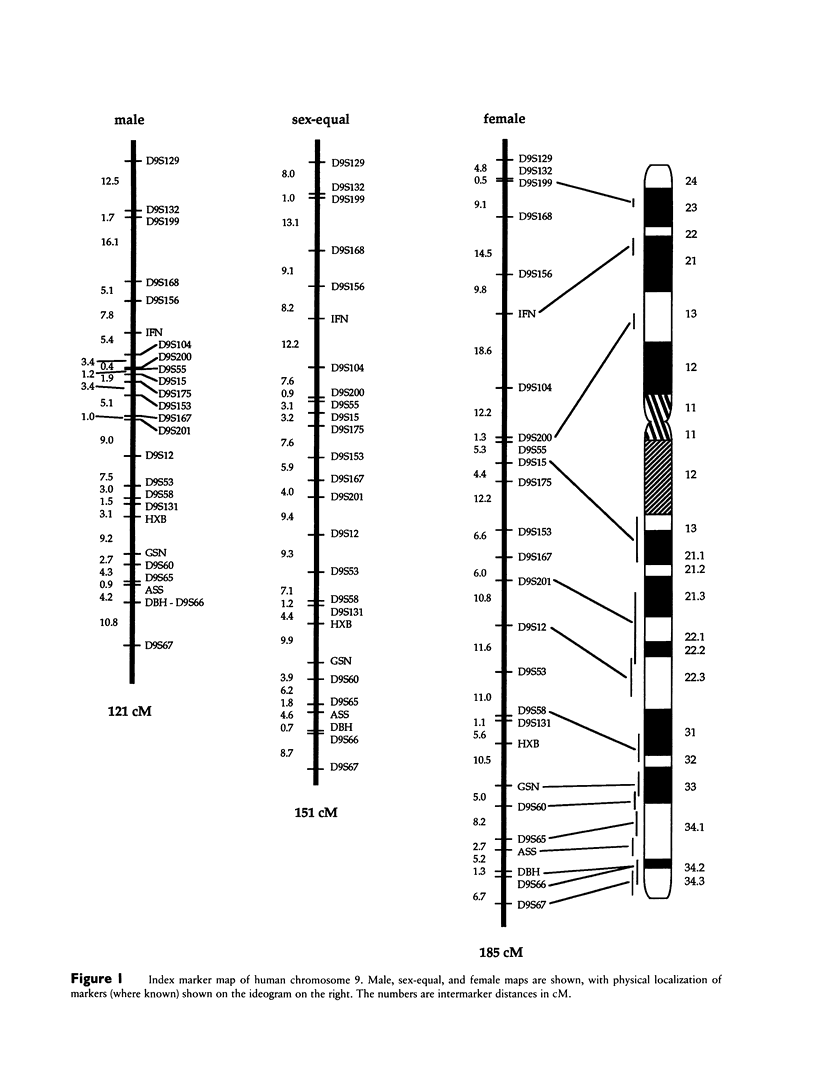
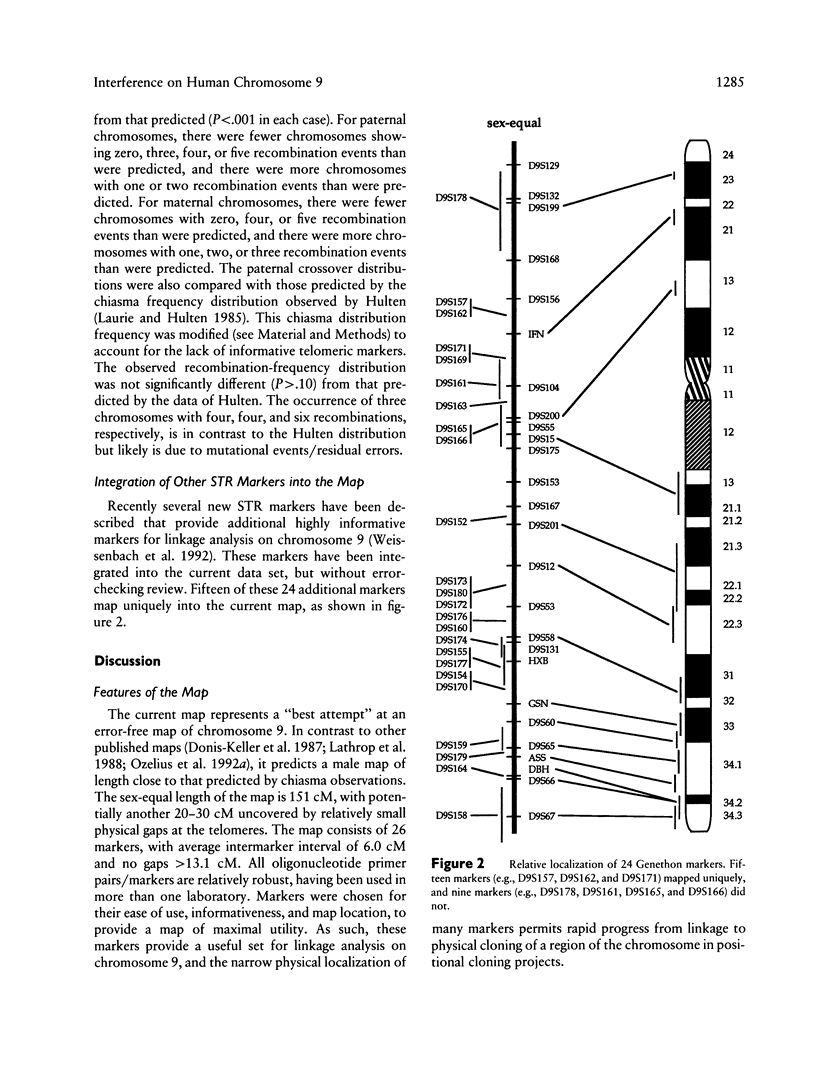
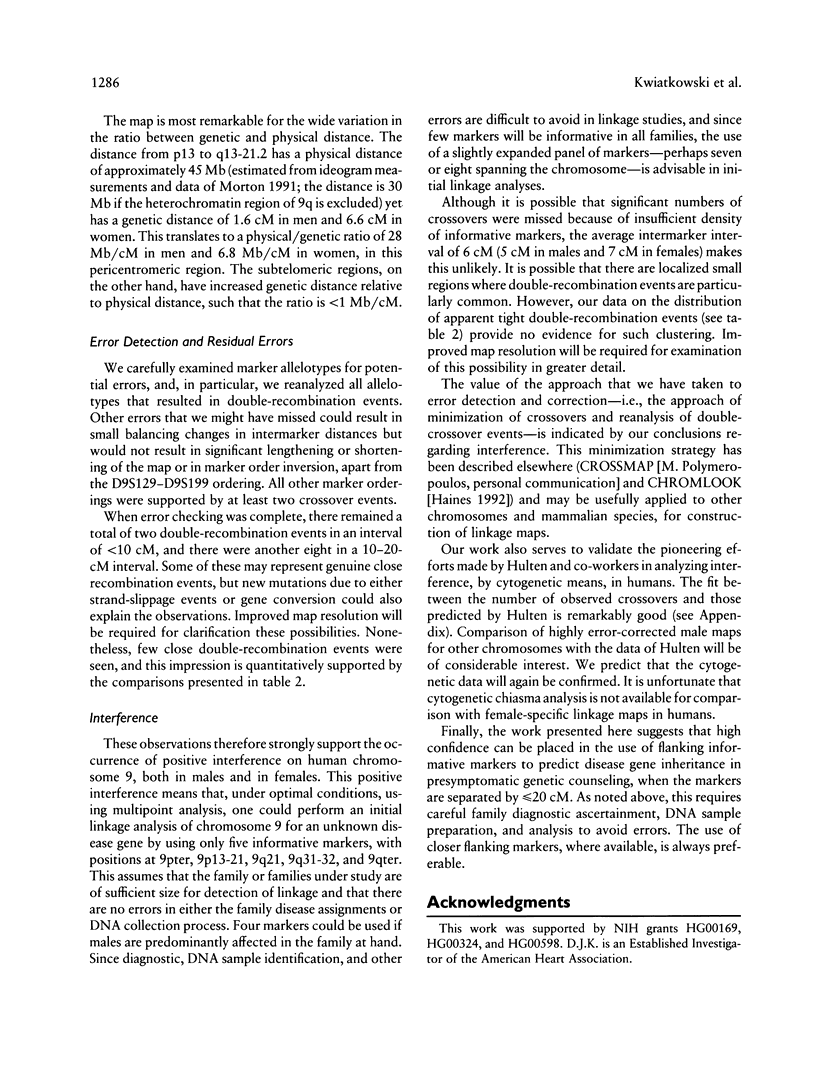
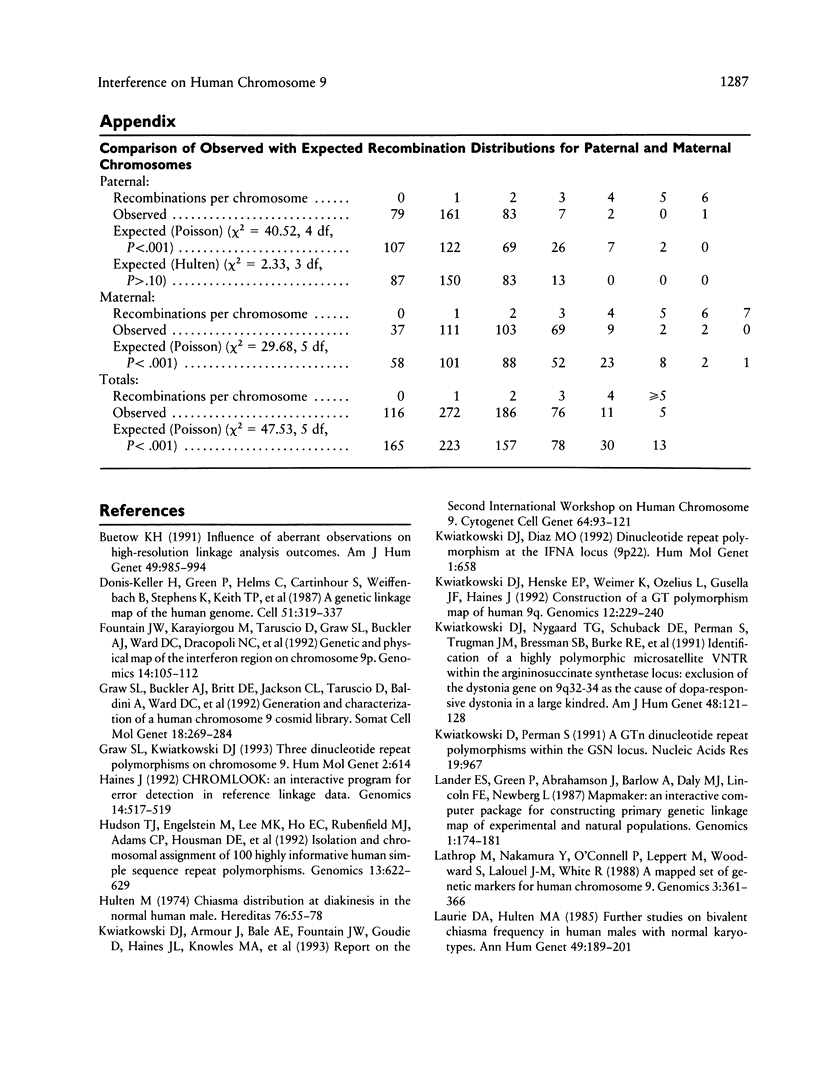
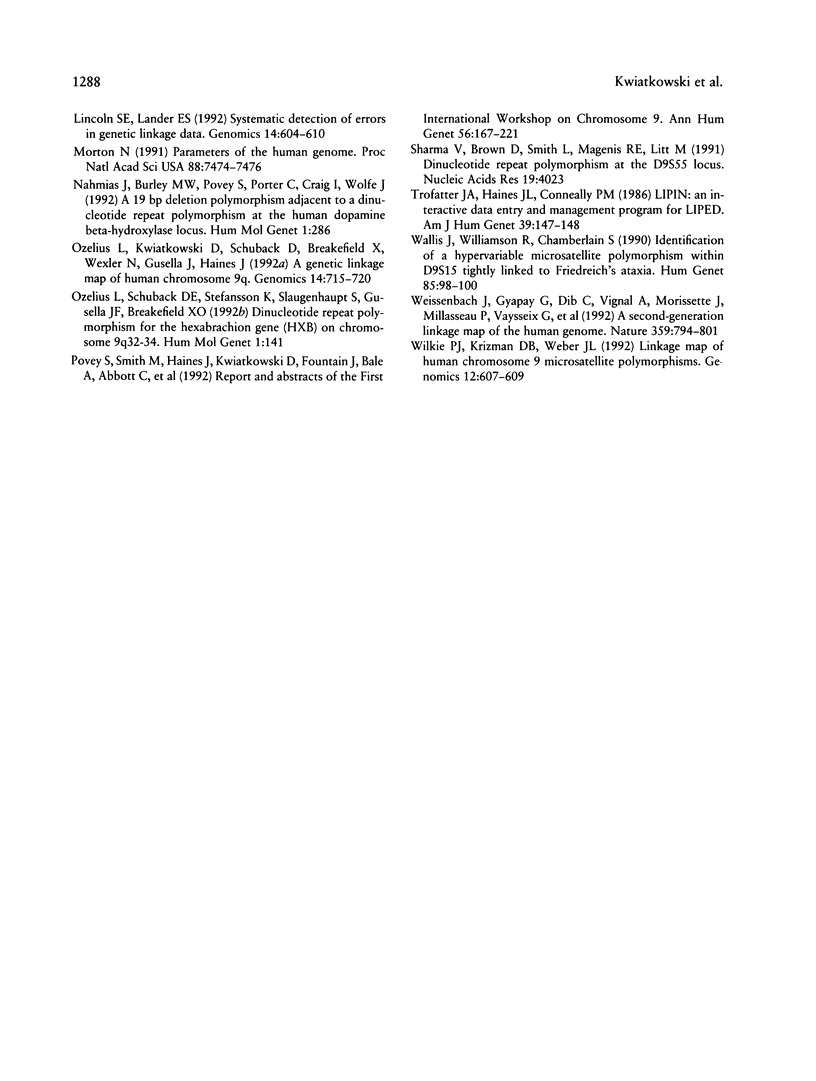
Selected References
These references are in PubMed. This may not be the complete list of references from this article.
- Buetow K. H. Influence of aberrant observations on high-resolution linkage analysis outcomes. Am J Hum Genet. 1991 Nov;49(5):985–994. [PMC free article] [PubMed] [Google Scholar]
- Donis-Keller H., Green P., Helms C., Cartinhour S., Weiffenbach B., Stephens K., Keith T. P., Bowden D. W., Smith D. R., Lander E. S. A genetic linkage map of the human genome. Cell. 1987 Oct 23;51(2):319–337. doi: 10.1016/0092-8674(87)90158-9. [DOI] [PubMed] [Google Scholar]
- Fountain J. W., Karayiorgou M., Taruscio D., Graw S. L., Buckler A. J., Ward D. C., Dracopoli N. C., Housman D. E. Genetic and physical map of the interferon region on chromosome 9p. Genomics. 1992 Sep;14(1):105–112. doi: 10.1016/s0888-7543(05)80290-3. [DOI] [PubMed] [Google Scholar]
- Graw S. L., Buckler A. J., Britt D. E., Jackson C. L., Taruscio D., Baldini A., Ward D. C., Housman D. E. Generation and characterization of a human chromosome 9 cosmid library. Somat Cell Mol Genet. 1992 May;18(3):269–284. doi: 10.1007/BF01233863. [DOI] [PubMed] [Google Scholar]
- Graw S. L., Kwiatkowski D. J. Three dinucleotide repeat polymorphisms on chromosome 9 (D9S200, D9S201, D9S199). Hum Mol Genet. 1993 May;2(5):614–614. doi: 10.1093/hmg/2.5.614-a. [DOI] [PubMed] [Google Scholar]
- Haines J. L. Chromlook: an interactive program for error detection and mapping in reference linkage data. Genomics. 1992 Oct;14(2):517–519. doi: 10.1016/s0888-7543(05)80257-5. [DOI] [PubMed] [Google Scholar]
- Hudson T. J., Engelstein M., Lee M. K., Ho E. C., Rubenfield M. J., Adams C. P., Housman D. E., Dracopoli N. C. Isolation and chromosomal assignment of 100 highly informative human simple sequence repeat polymorphisms. Genomics. 1992 Jul;13(3):622–629. doi: 10.1016/0888-7543(92)90133-d. [DOI] [PubMed] [Google Scholar]
- Hultén M. Chiasma distribution at diakinesis in the normal human male. Hereditas. 1974;76(1):55–78. doi: 10.1111/j.1601-5223.1974.tb01177.x. [DOI] [PubMed] [Google Scholar]
- Kwiatkowski D. J., Armour J., Bale A. E., Fountain J. W., Goudie D., Haines J. L., Knowles M. A., Pilz A., Slaugenhaupt S., Povey S. Report and abstracts of the Second International Workshop on Human Chromosome 9 Mapping 1993. Cytogenet Cell Genet. 1993;64(2):93–121. doi: 10.1159/000133566. [DOI] [PubMed] [Google Scholar]
- Kwiatkowski D. J., Diaz M. O. Dinucleotide repeat polymorphism at the IFNA locus (9p22). Hum Mol Genet. 1992 Nov;1(8):658–658. doi: 10.1093/hmg/1.8.658-a. [DOI] [PubMed] [Google Scholar]
- Kwiatkowski D. J., Henske E. P., Weimer K., Ozelius L., Gusella J. F., Haines J. Construction of a GT polymorphism map of human 9q. Genomics. 1992 Feb;12(2):229–240. doi: 10.1016/0888-7543(92)90370-8. [DOI] [PubMed] [Google Scholar]
- Kwiatkowski D. J., Nygaard T. G., Schuback D. E., Perman S., Trugman J. M., Bressman S. B., Burke R. E., Brin M. F., Ozelius L., Breakefield X. O. Identification of a highly polymorphic microsatellite VNTR within the argininosuccinate synthetase locus: exclusion of the dystonia gene on 9q32-34 as the cause of dopa-responsive dystonia in a large kindred. Am J Hum Genet. 1991 Jan;48(1):121–128. [PMC free article] [PubMed] [Google Scholar]
- Kwiatkowski D. J., Perman S. Dinucleotide repeat polymorphism at the GSN locus (9q32-34). Nucleic Acids Res. 1991 Feb 25;19(4):967–967. [PMC free article] [PubMed] [Google Scholar]
- Lander E. S., Green P., Abrahamson J., Barlow A., Daly M. J., Lincoln S. E., Newberg L. A., Newburg L. MAPMAKER: an interactive computer package for constructing primary genetic linkage maps of experimental and natural populations. Genomics. 1987 Oct;1(2):174–181. doi: 10.1016/0888-7543(87)90010-3. [DOI] [PubMed] [Google Scholar]
- Lathrop M., Nakamura Y., O'Connell P., Leppert M., Woodward S., Lalouel J. M., White R. A mapped set of genetic markers for human chromosome 9. Genomics. 1988 Nov;3(4):361–366. doi: 10.1016/0888-7543(88)90128-0. [DOI] [PubMed] [Google Scholar]
- Laurie D. A., Hultén M. A. Further studies on bivalent chiasma frequency in human males with normal karyotypes. Ann Hum Genet. 1985 Jul;49(Pt 3):189–201. doi: 10.1111/j.1469-1809.1985.tb01693.x. [DOI] [PubMed] [Google Scholar]
- Lincoln S. E., Lander E. S. Systematic detection of errors in genetic linkage data. Genomics. 1992 Nov;14(3):604–610. doi: 10.1016/s0888-7543(05)80158-2. [DOI] [PubMed] [Google Scholar]
- Morton N. E. Parameters of the human genome. Proc Natl Acad Sci U S A. 1991 Sep 1;88(17):7474–7476. doi: 10.1073/pnas.88.17.7474. [DOI] [PMC free article] [PubMed] [Google Scholar]
- Nahmias J., Burley M. W., Povey S., Porter C., Craig I., Wolfe J. A 19 bp deletion polymorphism adjacent to a dinucleotide repeat polymorphism at the human dopamine beta-hydroxylase locus. Hum Mol Genet. 1992 Jul;1(4):286–286. doi: 10.1093/hmg/1.4.286. [DOI] [PubMed] [Google Scholar]
- Ozelius L. J., Kwiatkowski D. J., Schuback D. E., Breakefield X. O., Wexler N. S., Gusella J. F., Haines J. L. A genetic linkage map of human chromosome 9q. Genomics. 1992 Nov;14(3):715–720. doi: 10.1016/s0888-7543(05)80173-9. [DOI] [PubMed] [Google Scholar]
- Ozelius L., Schuback D. E., Stefansson K., Slaugenhaupt S., Gusella J. F., Breakefield X. O. Dinucleotide repeat polymorphism for the hexabrachion gene (HXB) on chromosome 9q32-34. Hum Mol Genet. 1992 May;1(2):141–141. doi: 10.1093/hmg/1.2.141-a. [DOI] [PubMed] [Google Scholar]
- Povey S., Smith M., Haines J., Kwiatkowski D., Fountain J., Bale A., Abbott C., Jackson I., Lawrie M., Hultén M. Report and abstracts of the First International Workshop on Chromosome 9. Held at Girton College Cambridge, UK, 22-24 March, 1992. Ann Hum Genet. 1992 Jul;56(Pt 3):167–182. doi: 10.1111/j.1469-1809.1992.tb01145.x. [DOI] [PubMed] [Google Scholar]
- Sharma V., Brown D., Smith L., Magenis R. E., Litt M. Dinucleotide repeat polymorphism at the D9S55 locus. Nucleic Acids Res. 1991 Jul 25;19(14):4023–4023. [PMC free article] [PubMed] [Google Scholar]
- Trofatter J. A., Haines J. L., Conneally P. M. LIPIN: an interactive data entry and management program for LIPED. Am J Hum Genet. 1986 Jul;39(1):147–148. [PMC free article] [PubMed] [Google Scholar]
- Wallis J., Williamson R., Chamberlain S. Identification of a hypervariable microsatellite polymorphism within D9S15 tightly linked to Friedrich's ataxia. Hum Genet. 1990 Jun;85(1):98–100. doi: 10.1007/BF00276331. [DOI] [PubMed] [Google Scholar]
- Weissenbach J., Gyapay G., Dib C., Vignal A., Morissette J., Millasseau P., Vaysseix G., Lathrop M. A second-generation linkage map of the human genome. Nature. 1992 Oct 29;359(6398):794–801. doi: 10.1038/359794a0. [DOI] [PubMed] [Google Scholar]
- Wilkie P. J., Krizman D. B., Weber J. L. Linkage map of human chromosome 9 microsatellite polymorphisms. Genomics. 1992 Mar;12(3):607–609. doi: 10.1016/0888-7543(92)90456-3. [DOI] [PubMed] [Google Scholar]


